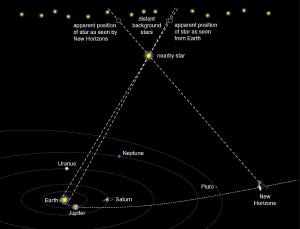Blog
A Wider View
26 April 2020
It isn’t easy to measure the distance of stars. We can’t travel to them, counting the miles as we go, nor can we simply say that brighter stars are closer and dimmer ones more distant. Instead, we must use a trick of geometry known as parallax.
We use parallax every day. It is one of the ways our minds figure out whether objects we see are near or far. Each of our eyes sees the world from a slightly different location, and that means closer objects appear shifted slightly when compared to more distant objects. We usually don’t notice the shift, but you can see it by covering one eye with your hand, then moving your hand to cover the other one instead.
 Brian May
Brian MayAstronomers use parallax by using the motion of the Earth around the Sun. They can look at a nearby star and note its apparent position, then do the same thing several months later. The closer a star is, the greater its parallax shift. This trick is so useful that astronomers have used it to define the astronomical distance known as the parsec, which is about 3.3 light years. Parsec stands for parallax arcsecond, because a star one parsec away will have a maximum parallax shift of one arcsecond.
The main limitation of parallax is that it depends on the distance of the Earth from the Sun. Even the closest stars have parallax less than one arcsecond, so it is difficult to get a really accurate measure. What would be great is to send a spaceship into deep space, so that you could compare its view to the view from Earth. The more widely separated the views, the bigger the parallax would be.
Fortunately we have just such a spacecraft. The New Horizons mission to Pluto has traveled well into the Kuiper belt region of the outer solar system. It is nearly 50 times farther from the Sun than Earth, giving it a unique view of the heavens. And since it isn’t busy at the moment, the New Horizons team has decided to look at the nearby stars Proxima Centauri and Wolf 359. By comparing this to the view of these stars on Earth, astronomers will be able to view stellar parallax better than ever before.
New Horizons was never designed to undertake this kind of study. But astronomers are always finding new ways to take advantage of the tools they have at hand. Or in space.